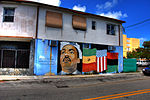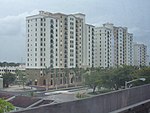Gladeview, Florida
Census-designated places in FloridaCensus-designated places in Miami-Dade County, FloridaUse mdy dates from July 2023

Gladeview is a census-designated place (CDP) in Miami-Dade County, Florida, United States. It is part of the Miami metropolitan area of South Florida. The population was 14,927 at the 2020 census, up from 11,535 in 2010. Gladeview was originally a neighborhood of the city of Miami when it was annexed in 1925. With the arrival of the Great Depression, Miami gave up its jurisdiction and Gladeview became an unincorporated area of Miami-Dade County.
Excerpt from the Wikipedia article Gladeview, Florida (License: CC BY-SA 3.0, Authors, Images).Gladeview, Florida
Zum Arnstal, Triptis
Geographical coordinates (GPS) Address Nearby Places Show on map
Geographical coordinates (GPS)
| Latitude | Longitude |
|---|---|
| N 25.84 ° | E -80.235555555556 ° |
Address
Zum Arnstal 1
07819 Triptis, Lemnitz
Thüringen, Deutschland
Open on Google Maps





